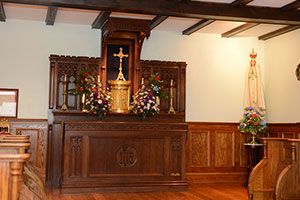
What do you get for the homeowner who has everything?
In today’s materialist world, the answer is to look for something new and trendy. The market is full of new gadgets and home improvements to maximize comfort and convenience.
However, some large homeowners seek something beyond the material. They are building home chapels.
The Home Chapel Trend
The Wall Street Journal (2/8/24) reports that home chapels are appearing more frequently in large houses across America. The trend is a surprising expression of long-neglected spiritual desires.
Home chapels were once thought of as something found in medieval feudal manors, not modern neighborhoods. In more Catholic times, large households often had chapels to care for the spiritual welfare of the families and servants.
Today’s chapels have a more personal purpose than in the past. They can be house additions or stand-alone structures. They are not meant to replace the church to which the owners might belong or provide services beyond the immediate family.
Private Spaces Reserved for God
Families are building these private and quiet spaces where they might hold weddings, baptisms or special events that mark their lives. In a fast-paced daily life, a chapel also slows a person down and provides a quiet place for prayer and meditation. It is a space reserved for conversing with God.
Help Remove Jesus Bath Mat on Amazon
And these are not just any chapels or simple shrines. These new additions can cost hundreds of thousands of dollars to build and furnish.
Architects report the structures are not a passing fancy. It is a three-decade-long trend that is growing in number and quality.
The Demand for Sacred Space
This demand for better sacred space has given rise to architectural schools specializing in designing traditional religious structures that speak to the soul.
One such school is at the University of Notre Dame. Its Institute for Sacred Architecture caters to chapels, convents and parishes that want to return to the churches that don’t look like airplane hangars. Many of the school’s projects resemble sublime medieval churches.
Satanic Christ Porn-blasphemy at Walmart — Sign Petition
Its magazine, the Sacred Architecture Journal, highlights the rejection of the post-conciliar brutalist and modernist architectural structures in the Catholic Church that litter the ecclesiastical landscape. One of its articles rightly proclaims, “Beauty is necessary for prayer.”
The Tendency to Make More Elaborate
“It used to be that people wanted something very simple,” says Duncan Stroik, the magazine’s editor. “Over the last 20 years, people have thought, ‘Why not make this the most beautiful room in the house?’”
Over time, these chapels have become increasingly elaborate, with special lighting, high ceilings, stained glass, Gothic arches, and gold leaf columns. The furnishings include antique altars, kneelers, pews, holy water fonts, and ornate statues.
Ironically, many furnishings for the new chapels come from churches “wreckovated” in the sixties and seventies to make way for the sterile brutalist designs that reflected a similarly gutted theology. Everything the renovators threw away, the new chapel builders crave.
How Panera’s Socialist Bread Ruined Company
To meet demand, dealers of church furnishings have sprung up all over the country and cater to a booming market of those who appreciate the sacred. They say homeowners can easily spend $10,000 to furnish their new chapels.
The Thirst of the Divine
The emergence of home chapels must be seen in a broader context than just one more accessory to add to the value of a house. The trend fills a void.
These efforts are happening spontaneously without the active participation of Church officials. People naturally sense the need to address God in their lives and take action on their own.
The trend represents a yearning for something beyond comfort. When people build their chapels, they seek the good, true and beautiful found in the Divine. In the silence of sacred space, the soul can reflect on the purpose of life and present petitions for Divine aid. Above all, God can speak to the soul.
What Does Saint Thomas Aquinas Say About Marriage?
By building a chapel, the owner is inviting God into the home. By making it the most beautiful room in the house, the person recognizes God’s primary place in one’s life. The chapel builders represent one of those paradoxes where people feel the emptiness of the postmodern world that promises everything and wishes to fill it with the only thing that can satisfy the soul—God.


